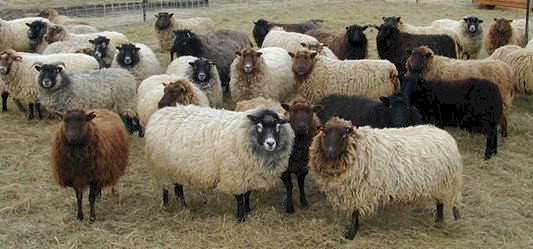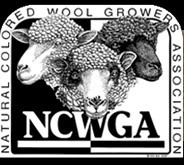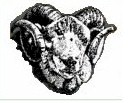Shetland Sheep are one of the smallest of the British sheep.
The ewes are usually hornless, and the rams have nicely-rounded horns, not too
heavy, nor too close together. Their head is well carried, their face is of
medium length with a straight nose and bright eyes, the back is straight and of
medium length.
They originated in the Shetland Isles, but is they are now
kept in many other parts of the world. They are part of the Northern European
short-tailed sheep group. Shetlands are classified as a landrace or
"unimproved" breed. They are kept for their very fine wool, for meat,
and for conservation grazing.
Although Shetlands are small and slow-growing compared to
commercial breeds, they are hardy, thrifty, easy lambers, adaptable and
long-lived. They have survived for centuries in difficult conditions and on a
poor diet, but they thrive in better conditions. They retain many of their
primitive survival instincts, so they are easier to care for than many modern
breeds.
Up to the Iron Age, the sheep of the British Isles and other
parts of northern and western Europe were small, short-tailed, horned only in
the male and variable in color. Short-tailed sheep were gradually displaced by
long-tailed types, leaving short-tailed sheep restricted to the less accessible
areas.These included the Scottish Dunface, which until the late eighteenth
century was the main sheep type throughout the Highlands and Islands of
Scotland, including Orkney and Shetland.The Dunface died out on the mainland,
Scotland, in the late nineteenth century, leaving its descendants limited to a
few islands, including the Shetlands. The Shetland type of the Dunface has been
regarded as a distinct breed since the early nineteenth century or before.
By the early twentieth century, Shetland sheep were perceived
as threatened by cross-breeding, leading to a decline in wool quality. To
combat this, the Shetland Flock Book Society was formed in 1927, and this
remains the body responsible for the sheep's protection on their native
islands.
By the time the Rare Breeds Survival Trust was set up in the
1970s, the Shetland had become rare, and they were listed by them as
Endangered. Since then, they have become popular with smallholders, they have a
population of over 3000 in the UK.
The US President Thomas Jefferson for several years owned a
Shetland Ram. Unlike modern Shetlands (but like some related breeds) this ram
had four horns. He was kept with about 40 other sheep on President's Square in
front of the White House. In the spring of 1808, it attacked several people who
had taken shortcuts across the square, injuring some and actually killing a
small boy. Having been moved to Jefferson's private estate at Monticello, the
ram was eventually killed after having killed several other rams: it was
described by Jefferson as "this abominable animal". Such aggressive
Shetland rams, however, are unusual. In North America, the original Jefferson
flock of Shetlands did not persist.
Other importations were made at the beginning of the
twentieth century most notably to Mrs. W.W. Burch of Coopersville, MI (wife of
the Editor of the American Sheep Breeder at the time), and Mr. L.V. Harkness of
the Walnut Hall (the same of Standardbred Horse fame). There is record of these
flocks surviving until 1916, and also record of another flock in Illinois in
1917. By 1921, it was recorded that Shetlands could not be bought in the U.S.
(The Sheep Breeder, 1921). It was not until the mid-twentieth century that
Shetlands were imported into Canada, and then from Canada into the United
States in the 1980s. Since then, a North American Shetland Sheep Registry has
been established, and there are now thousands of them in the US and Canada.
In November 2011, Shetland wool produced in the Shetlands
gained protected geographical status with a protected designation of origin
(PDO) classification as "Native Shetland Wool". It was the first
non-food product in the UK to receive this status.
Shetlands appear in a wide variety of colors and patterns
although solid white and solid moorit (reddish-brown) or black are most common.
Many of the colors and patterns have Shetland dialect names – these derive from
the Norn language formerly spoken in Shetland, and similar names are also used
in at least one other Nordic language: Icelandic. Eleven main colors are recognized
by the breed association (most including many different shades): light grey,
grey, white, emsket (dusky bluish-grey), musket (light greyish-brown), shaela
(dark steely-grey), black, fawn, moorit (reddish brown), mioget (honey-toned,
yellowish-brown), and dark brown.
Thirty different coat patterns and markings are recognised,
many of which can occur in combination. They include katmoget
("badgerface": dark belly and dark shading around nose and eyes,
lighter elsewhere), gulmoget ("mouflon", the reverse of katmoget:
light belly, dark face with light marks around eyes, dark elsewhere), yuglet
(generally light with dark "panda" patches around the eyes), bleset
(dark with white blaze down face), smirslet (white marking around the muzzle),
sokket (with white socks on the legs), bersugget (irregular patches of
different colours) and bielset (with a collar of a differing color).
The wool produced by the Shetland has historically been a
valuable commodity. Shetlands produce numerous shades of wool colors , and this
variety was commercially important to the wool industry of the Shetland Isles,
where natural wools are often used undyed. Tweed is also produced from the
coarser Shetland wool, but the Isles are best known for their multicolored
knitwear (made using Fair Isle knitting) and for the traditional knitted lace
shawls which are so fine, they will pass through a wedding ring. Fleeces
usually weigh between 2 and 4 lb (0.9 and 1.8 kg).
The rams weigh approximately 90 to 125 lb (41 to 57 kg) and
ewes about 75 to 100 lb (34 to 45 kg).
Like other "primitive" breeds, the ewes are highly
seasonal, becoming fertile in October and November (in the Northern Hemisphere)
and lambing in spring or summer. On the poor grazing of the breed's native
isles, the lambing percentage is about 130%. However, when the ewes are on
better pasture, twin lambs are more common, especially from mature ewes.
Shetland ewes are hardy, easy lambers, good mothers and produce ample milk.
Healthy lambs are born with a weight between 4 and 7 lb (2 and 3 kg).
Forage conversion to milk with Shetland ewes is excellent.
Because of the Shetland ewe's forage conversion efficiency, lamb growth is
fast. A good Shetland ewe on adequate forage can wean off 150% of her body
weight in purebred twins by fall. Some ewes wean singles nearly as big as
themselves. A heavier Shetland ewe at 80 lbs (36 kg) can wean 60 lb (27 kg)
purebred twins. What makes the Shetland ewe an optimal maternal base for
grassfed lamb production is her prowess in producing hybrid market lambs: take
the same ewe and breed her to, for example, a Leicester, Texel, Charollais or
Berrichon ram, and keep her on the same pasture management system. In some
flocks, ewes can wean off pairs of 90 lb (40 kg) twins at only 120-150 days
old- each crossbred lamb weighing more than their dam.
Shetland lamb is high quality, with positive reviews from
chefs and home cooks alike. Texture and flavor are good, with high-yielding
carcasses. The mutton also has nice flavor, with some customers and many breeders
preferring mutton over lamb.
Lines that have been bred with selection pressure focused on
uniformity and finer fiber diameter often do not perform as optimally as lamb
producers, and vice versa. Shetland breeders find it imperative that the breed maintains
a balance in its ability to produce both a quality fleece and carcass, managed
relatively holistically.



